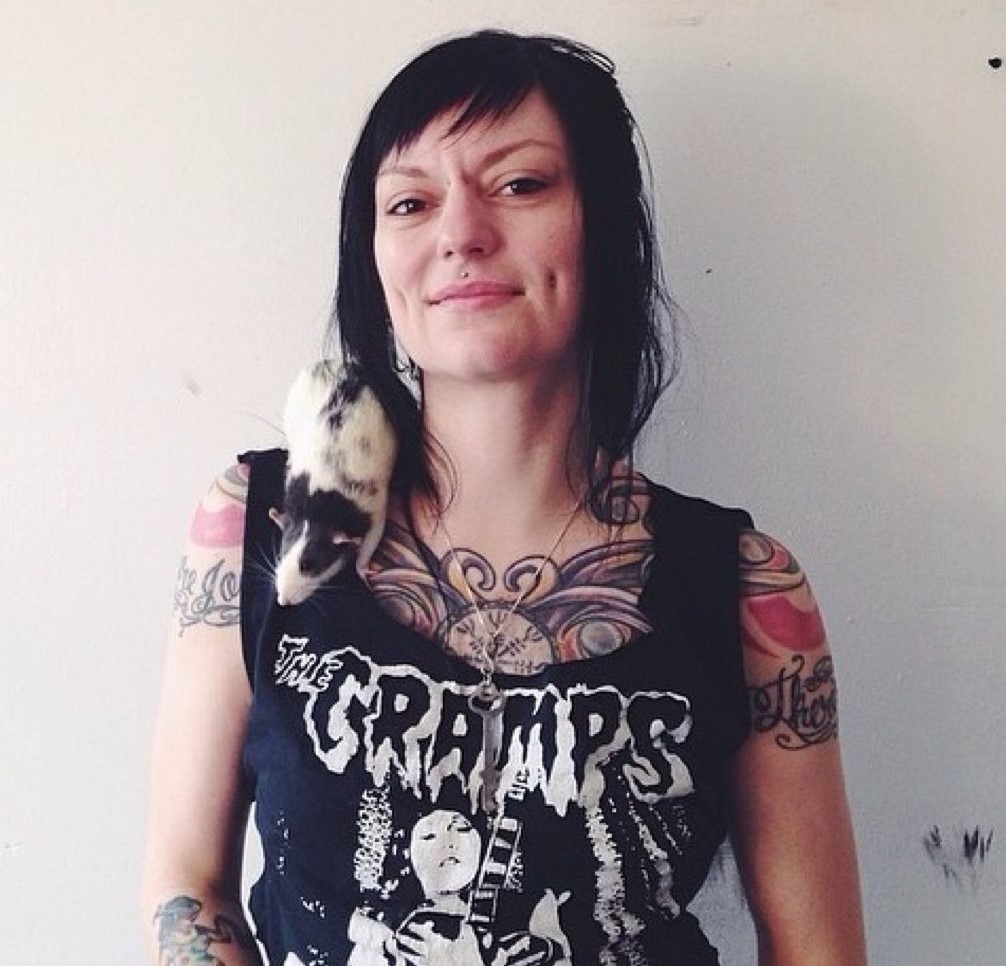
Multidisciplinary artist Sarah Best creates sculptural pieces which lay bare the more isolating and divisive aspects of the human condition.
Simultaneously fragile and strong, feminine and masuline, handmade but depicting natural elements, Sarah’s work thrives in contradiction.
In many of her pieces feminine bodies are wrenched apart and reconfigured to create a provocative new whole that is at once more vulnerable and newly strengthened.
From her dynamic, fractured mixed media shadow box collages to her plaster casts of extremities, she challenges the viewer to confront erosion of self.
With so much coverage of the pandemic focused on body counts and the toll on the economy, it often seems the human toll is missing from the conversation. Since Sarah’s work is so concerned with the social constructs that bring about dehumanization, I reached out to her to get her insights on current affairs. Sarah also shares some compelling thoughts about the art world.
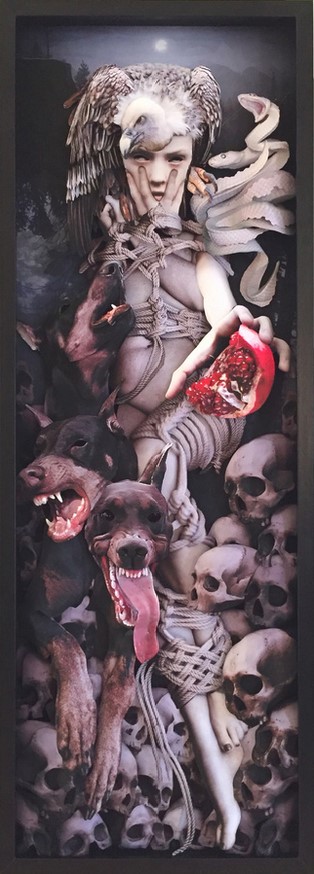
You are currently living in Portland, Oregon. How has your daily life changed since the spread of Covid-19?
I’m one of those people who discovered my usual daily life is considered “quarantine”. I am cooking a lot more these days. Consider that a warning.
Oregon has seen relatively few documented Covid-19 cases. It’s currently the tenth lowest state in total cases. However the city of Portland is still under stay at home orders. What’s life been like in Portland?
It felt pretty eerie during the lock down. Honestly though, now that things have opened up more recently, it’s been feeling pretty normal except for all the facemasks.
Are people social distancing?
For the most part I see a concerted effort to maintain distance and wear masks in public, but the bar scene is feeling a little sketch. I have a false sense of security I can’t seem to shake.
Are there shortages?
Toilet paper and hand sanitizer were the hot commodities, but supply and demand seem to have leveled out at this point.
Do you think that the city is ready to reopen even on a limited basis?
I’m pretty sure the entire country isn’t ready. I think the only thing we can be ready for is a lot of touch and go and uncertainty until there’s a vaccine.
Do you feel safe?
I’m worried and anxious. There’s nothing quite like a rogue virus, economic crash, and uncertain future to help a person sleep at night.
What do you miss the most about your pre-pandemic life?
I miss being anywhere that isn’t called “home” or “the park.
Do you think those losses are temporary or permanent?
Temporary. But I don’t think anything will really be the same.
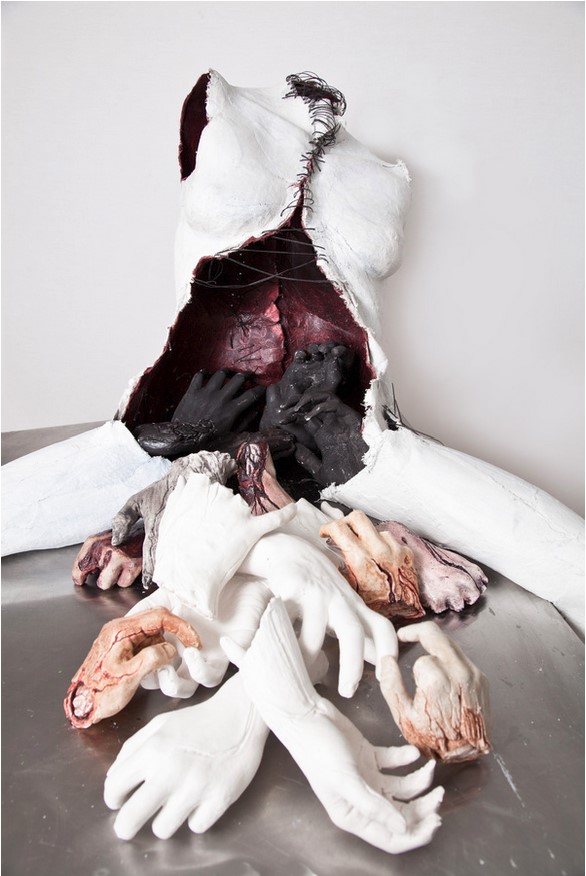
Has your creative process been affected during this time?
Money’s been super tight- choosing between paying bills and buying art supplies isn’t very conducive to the creative process.
Are you making art? If you are making art, what have you been working on?
I’ve been working with what I have, making studies and getting ideas together. It’s actually been a well-needed pause to read and write, and do all the things you do to feed your creativity. I’m usually so caught up in the studio grind- I forget it’s important to step away too, and make time for gestation. It can’t always be about production.
Where have you been taking inspiration from lately?
Current events.
Have you done any work that reflects on the pandemic or do you anticipate doing such work in the future?
I’m sure I will. Right now I’m feeling that nagging urge to respond as an artist- that’s the first sign.
A lot of your work deals with pieces of the human body such as limbs, hands, feet. Removed from the whole, they provoke questions about identity and ownership. Recently, I’ve been increasingly aware of how the language used by health media separates “the body” from the person. Thousands of headlines like “What Coronavirus does to the body”, “Here’s what happens to the body after contracting the new Coronovirus” and “Coronavirus infection may cause lasting damage throughout the body” almost negate any humanity. I wonder if this contributes to some members of society pushing to reopen even as the death toll continues to rise. What are your thoughts about society’s objectification of the body and the use of language and imagery that separates a body from a person?
Society objectifies because we’ve been conditioned to, and the media is at the heart of that. It serves to objectify and perpetuate objectification in order to preserve the status quo, and turn the biggest profit. That’s mainstream media; corporate conglomerates manipulating our perceptions and behaviors anyway they can- all day every day. Information drives behavior.

Your sculptures of extremities suspended from meat hooks remind me of the work of Carol J. Adams. Probably best known for her book The Sexual Politics of Meat: A Feminist-Vegetarian Critical Theory, Adams books focus on intersectional oppression. Adams draws parallels between the objectification and sexualization of animals and women by patriarchal society. She also argues that men who feel entitled to eat meat often feel entitled to access women’s bodies. I was curious if you were familiar with her work. And what feeds into the creation of your body part sculptures?
A lot of different things inform them, but Adam’s work is a major contributor. The idea of keeping something from being seen as having been someone; objectifying, fragmenting, allowing for the moral abandonment of another being, and also of one’s self. This is a theme that resonates throughout a lot of the work I’ve done.
In a time when people are more conscious of fears about the vulnerabilities of the body, does the role of your work, which puts images of the body on display shift or take on a different relevance?
I feel the relevance or the role remains the same; these works are ultimately meant to speak to the human condition on a tacit emotional level.
I think people’s heightened awareness is what has really shifted. People have been reaching out to me about this work now more than ever, which I think is interesting.
I feel people aren’t as uncomfortable with the works as they were when I initially began making them. They seem more willing to confront damage and breakdown. And, not just acknowledge vulnerability, but to understand that there is a level of strength involved- to own your vulnerabilities takes courage.
Have your own thoughts about your work been affected by the pandemic?
Yes. But I’m still taking things in and I honestly haven’t fully sorted all my thoughts just yet.
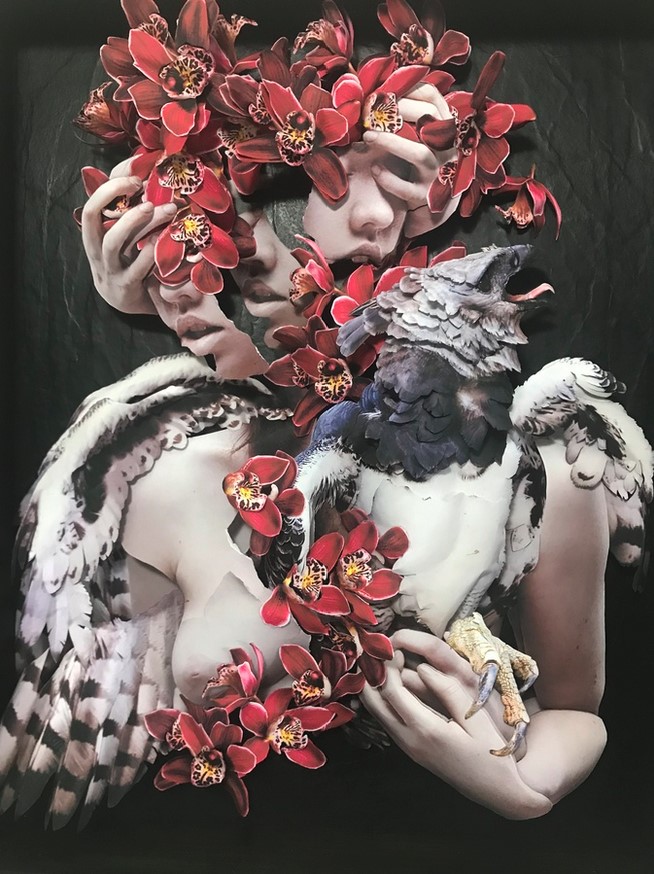
Animals such as birds, snakes and moths feature prominently in your collages. What do these animals symbolize in your work?
Regeneration, transformation, interiority, symmetry, form, being born and always becoming.
What does your work say about the relationship of humans to nature?
It’s a sacred relationship. I feel in some ways these works are a process of remembering this, and reconnecting. They’re my totems and ex-votos.
Additionally, what are your thoughts on humankind’s responsibilities to the animal kingdom at this time?
At this point probably the best thing we could do is disappear.
What (if any) is the role of art and the artist in a time of crisis?
I think at times an artist can choose to be the conscience of society- to bear witness. I think it is important for artists to embrace this role, because art has the ability to critique, and record, and communicate life in ways that conventional methods can’t always do. But I don’t think this is necessarily “the duty” or obligation of the artist.
I interpret your work as being very political and challenging to the status quo. But save for the images of your work, your infrequent postings on social media are generally apolitical. Captions to your work simply state what the work is. Do you consciously avoid expressing a point of view in an effort to allow the work to speak for itself and be open to interpretation? Or is there another reason your social media presence seems subdued?
Sometimes it’s intentional. Sometimes I’m curious to see how people will respond to or interpret the work without any cues. I want to see if they’re picking up what I’m putting down- if the language is clear, or the elements are working how I intended. I’m curious too of how much of what the viewer sees or reads into the work is their own contribution.
But anymore I feel that my “subdued” social media activity is a result of my conflicted feelings about social media as a whole. On the one hand it’s an indispensable tool for shameless self-promotion- what artist doesn’t need that? It creates accessibility and the opportunity to connect with people. Look at everything happening right now with the Black Lives Matter movement- the scale and persistence of the protests world wide, and the response from elected officials. Clearly social media has an incredible ability to empower and unify people, and effect society in positive ways.
On the other hand though, it acts as another insidious facet of the media monster spreading disinformation, inciting divisiveness and objectification, and obliterating any sense or even concept of privacy. Until I can rectify my feelings somehow, I choose for the time being to keep my social media activity to a minimum.
In your experience, does the art world have a diversity problem?
The art world is nothing but problems.
What steps could be taken to make it more inclusive?
The pandemic is doing a pretty good job for us. The entire establishment is completely out of hand- blockbuster exhibitions with star loans shipped carbon-intensively across the globe, insane auction prices, the infiltration of value into the perception of art, the mega-collectors, the purchasing of big trophy objects. They’ve completely reduced art to nothing but an end product, an asset.
None of this is inclusive or sustainable.
But the party’s over, and even if the art market bounces back it’s going to be a much smaller world. Everything is going to have to be recalibrated and rethought in order to adapt.
Our excessiveness as a whole and the imbalance it’s created has caught up with us.
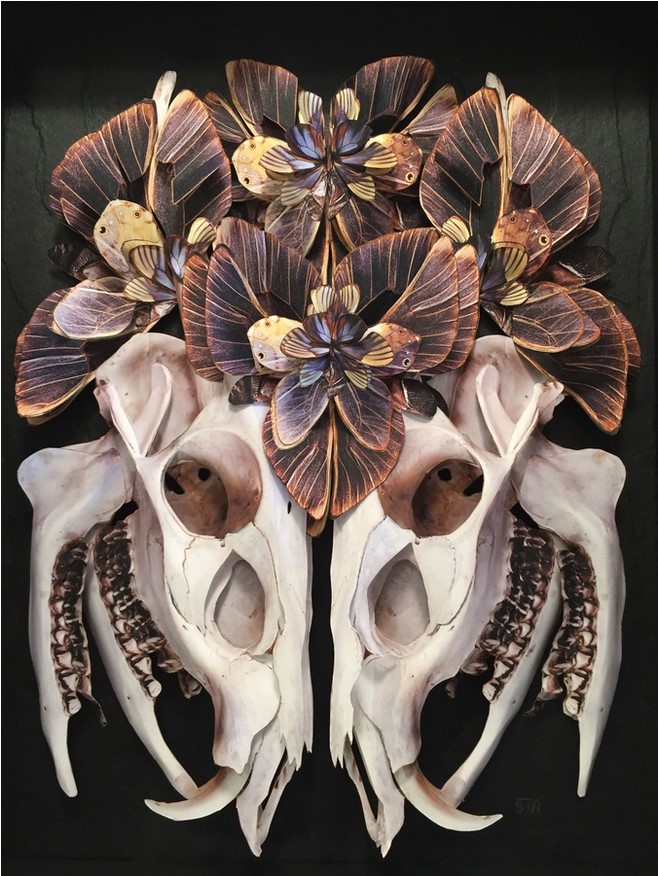
Your shadowbox work combines collage and paper sculpting in a way I’ve never seen before. How did you develop your style?
It developed from an obsessive compulsion toward collage entangled with an intense love for sculpture and painting.
When you’re a multi-disciplinary artist your skill sets inevitably influence one another and the thought processes overlap. So when I first decided to focus on collage I took a more cohesive, painterly approach and the dimensional questions followed. I wanted to give my collages a larger scale and presence, and for them to be more tactile and active. I wanted them to hold their own against the predominance of painting. But, more importantly, I wanted to find my own aesthetic voice rather than my “niche” or to be “fashionable”.
People say things like this as if it’s guidance, but what they’re really doing is sending a fat dose of poison straight to your creativity. Ignoring all the people who had my ear, and the litany of “art don’ts” and insecurities they tried to hang on me, has been the biggest key factor in my overall artistic development. I’ve learned to trust my instincts.
And what is the process of developing a new piece like?
A hard earned secret. If my carpel tunnels could speak, they’d bemoan themselves and disown me- that much I can tell you.
You’ve participated in many group gallery shows. What would it take for you to feel safe attending a big gallery opening in the future?
“Safe” is not a word I’d use to describe how I feel at a gallery opening ever. “Fight or flight” would be more accurate, with or without COVID. In fact I’d probably be more comfortable hanging out with just COVID.
Even before the pandemic, galleries were increasing their online presences. What, if anything, do we lose when artworks are primarily consumed on a screen?
It becomes a canned experience.
Technically speaking, you’re not even seeing the actual work at all. You’re seeing a representation made of pixels, usually on a cell phone shrunk down into a ridiculously small aspect ratio. You lose texture and depth, color, tone, scale, smell, sound, the artist’s hand, those small subtle moments- so much of the finer details go mostly unseen. You lose the moment when you’re standing in front of a work of art that really fucking rings your bell for whatever reasons.
Some works have an energy impressed upon them – it’s kind of hard to vibe that shit through a screen. I think excessive consumption of images in this way also makes for a passive audience; disengaged and infinitely scrolling to the next image. I have to make a conscious effort myself not to do this.
Having said all of that, the reproduction also serves a very significant and meaningful purpose in that it gives access to an endless amount of artwork that one might never have the opportunity to see otherwise. And right now during a pandemic, where you simply cannot see art in person, it’s the only option we have. Sometimes I guess you have to take what you can get and count your blessings.
Has your financial situation been affected by the spread of Covid-19?
Of course.
If it has, have you taken any steps to adapt?
I’m figuring out what those steps might be.
How can we support your work at this time?
Self-promotion is something I’ve never been comfortable with or good at, so when people share my art with others it’s incredibly helpful.
Commissioning artists whose work you appreciate is always an excellent way to support their creative endeavors as well.
Thank you very much to Sarah for taking the time to answer these questions.
Do you agree with Sarah that a reckoning has been a long time coming for the art world? Leave a comment and let us know what you think.
To see more of Sarah’s work, visit her website and follow her on Instagram.
Dahlia Jane
Dahlia Jane is a wicked writer living in Los Angeles. She writes about the dark arts scene, goth life and fascinations with the macabre. Dahlia spends her free time obsessing about skulls, devouring true crime and occult books, sewing and making messes.
For me this interview went from one point or agreement to the next. The love of nature,the dislike of social media and the view of mainstream art world all resonate with me. While I am seeing the actual pieces as pixels, Barking deer and Adytum both strike me as beautiful and brilliant. Thank you
Sarah’s work is incredibly nuanced and beautiful.